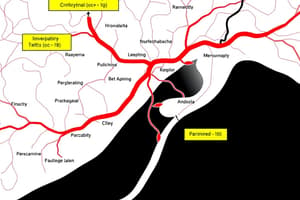Podcast
Questions and Answers
What is the main advantage of giving a drug by IV infusion?
What is the main advantage of giving a drug by IV infusion?
Allows precise control of plasma drug concentrations
What are the examples of parenteral routes of drug administration?
What are the examples of parenteral routes of drug administration?
Intravenous, subcutaneous, intramuscular
Why is IV infusion preferred for drugs with a narrow therapeutic window?
Why is IV infusion preferred for drugs with a narrow therapeutic window?
Maintains a constant plasma drug concentration
What does the plasma drug concentration-time curve of a drug given by constant IV infusion show?
What does the plasma drug concentration-time curve of a drug given by constant IV infusion show?
How does IV infusion of drugs, such as antibiotics, benefit patients?
How does IV infusion of drugs, such as antibiotics, benefit patients?
Explain why the rate of drug entering the body is equal to the rate of drug leaving the body at steady state in IV infusion.
Explain why the rate of drug entering the body is equal to the rate of drug leaving the body at steady state in IV infusion.
What does dCp/dt equal at steady state in terms of plasma drug concentration?
What does dCp/dt equal at steady state in terms of plasma drug concentration?
In the one-compartment model for drugs, what is the equation representing the change in the amount of drug in the body during infusion?
In the one-compartment model for drugs, what is the equation representing the change in the amount of drug in the body during infusion?
What is the equation that gives the plasma drug concentration at any time during IV infusion in the one-compartment model?
What is the equation that gives the plasma drug concentration at any time during IV infusion in the one-compartment model?
What does the steady-state drug concentration (Css) equal in terms of infusion rate, volume of distribution, and elimination rate constant?
What does the steady-state drug concentration (Css) equal in terms of infusion rate, volume of distribution, and elimination rate constant?
At infinite time during IV infusion, what value does e^(-kt) approach, and what does Equation 6.2 reduce to?
At infinite time during IV infusion, what value does e^(-kt) approach, and what does Equation 6.2 reduce to?
What is the relationship between the rate of drug leaving the body and the rate of drug entering the body at steady state?
What is the relationship between the rate of drug leaving the body and the rate of drug entering the body at steady state?
Flashcards are hidden until you start studying
Study Notes
Routes of Administration
- Drugs can be administered through oral, topical, parenteral, or other routes.
- Parenteral routes include intravenous, subcutaneous, and intramuscular administration.
Intravenous (IV) Administration
- IV drug solutions can be administered as a bolus dose (all at once) or infused slowly into the plasma at a constant rate (zero order).
- IV infusion allows for precise control of plasma drug concentrations, fitting individual patient needs.
- It maintains a constant plasma drug concentration, eliminating fluctuations between peak and trough levels.
Advantages of IV Infusion
- Suitable for drugs with a narrow therapeutic window (e.g., heparin).
- Can be administered with IV fluids containing electrolytes and nutrients.
- The duration of drug therapy can be maintained or terminated as needed.
Plasma Drug Concentration-Time Curve
- The curve shows the rise of drug levels from zero to a steady-state concentration.
- At steady state, the rate of drug leaving the body equals the rate of drug entering the body.
One-Compartment Model
- The pharmacokinetics of a drug given by constant IV infusion follow a zero-order input process.
- Elimination of the drug from the plasma is a first-order process.
- The infused drug follows zero-order input and first-order output.
Pharmacokinetic Equations
- The change in the amount of drug in the body (dDB/dt) is the rate of input minus the rate of output.
- The plasma drug concentration at any time during the IV infusion is described by Equation 6.2.
- The steady-state drug concentration (Css) is described by Equation 6.4.
Steady-State Drug Concentration (Css)
- At infinite time, the steady-state drug concentration is reached, where the rate of drug leaving the body equals the rate of drug entering the body.
- The body clearance, Cl, is equal to VDk, and Css is equal to R/Cl.
Studying That Suits You
Use AI to generate personalized quizzes and flashcards to suit your learning preferences.



